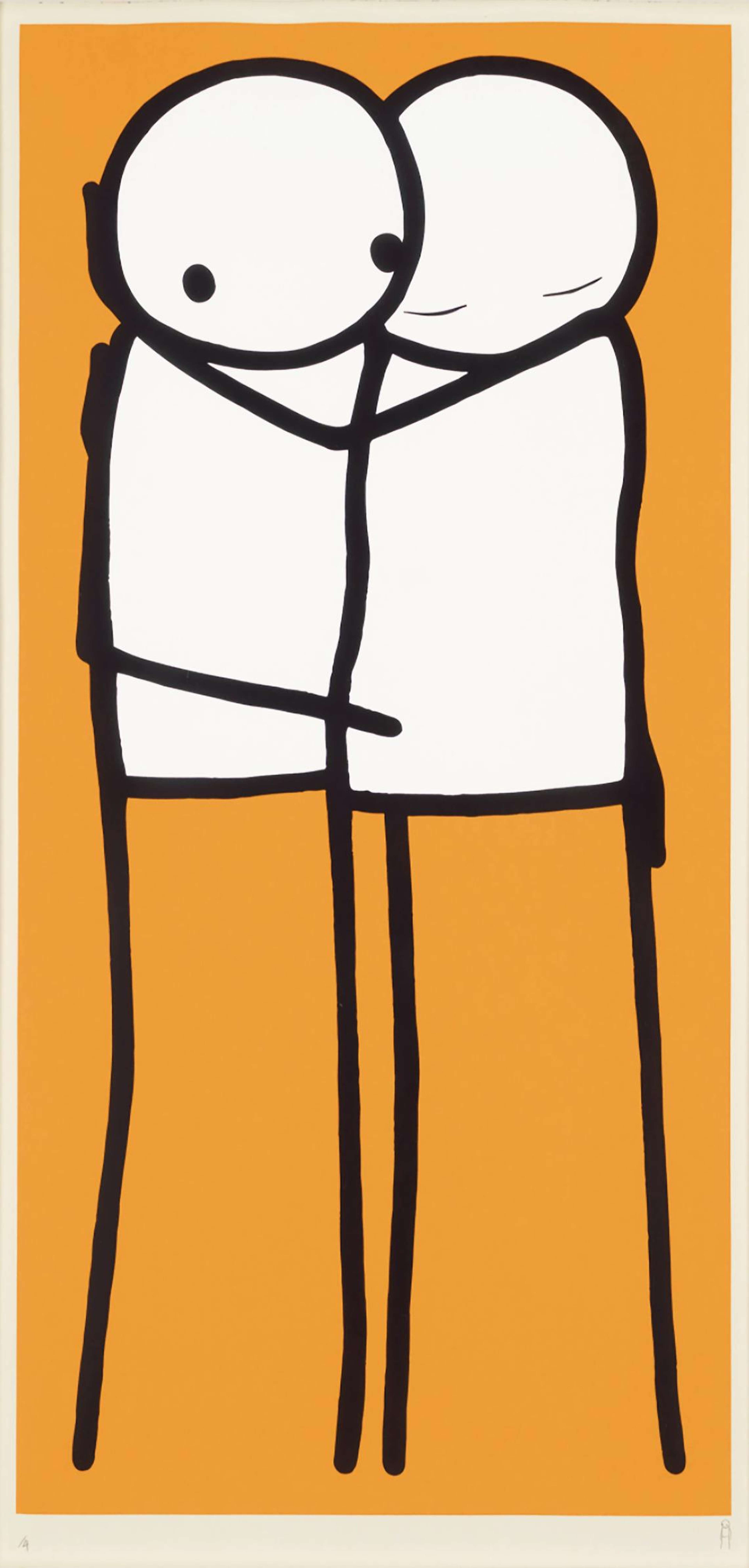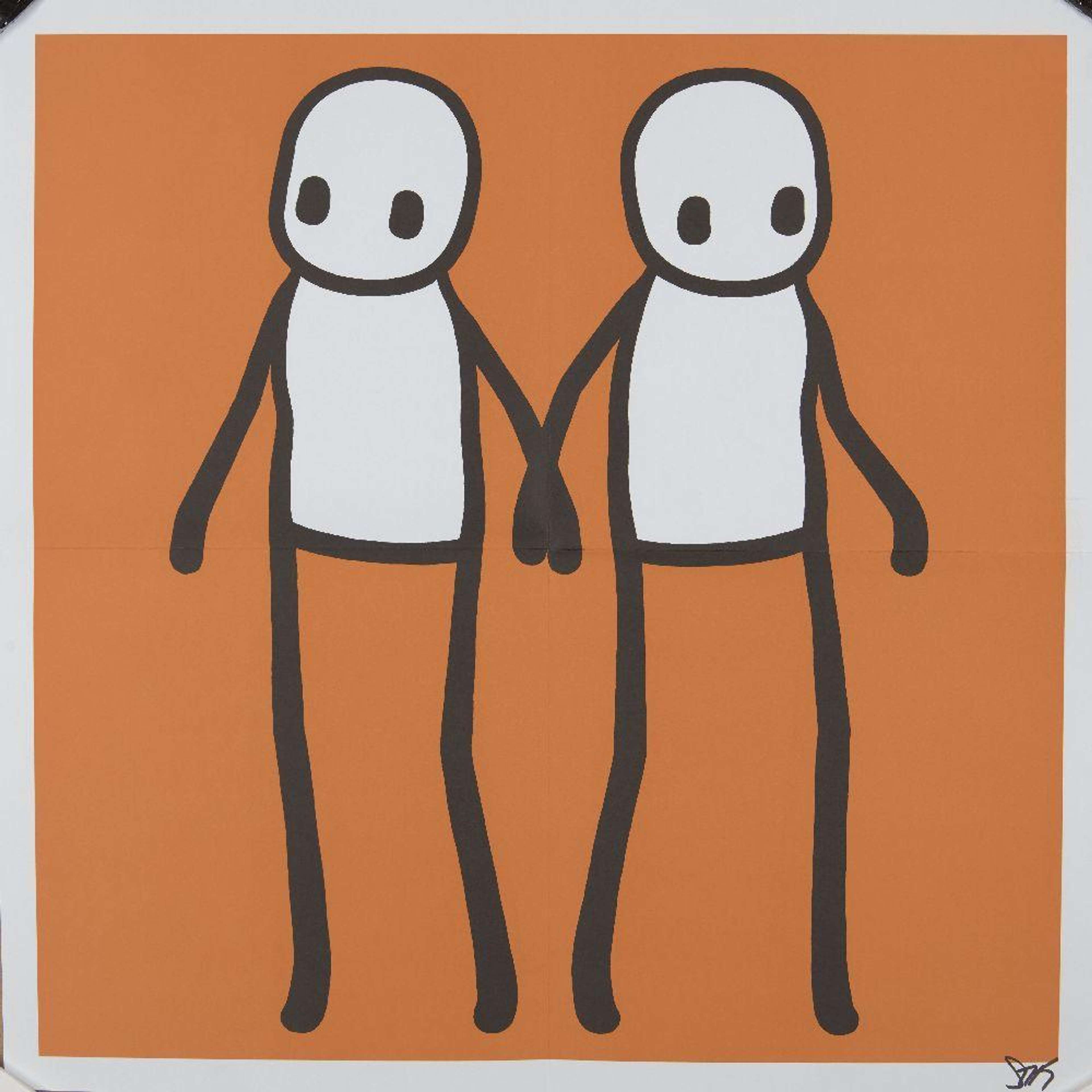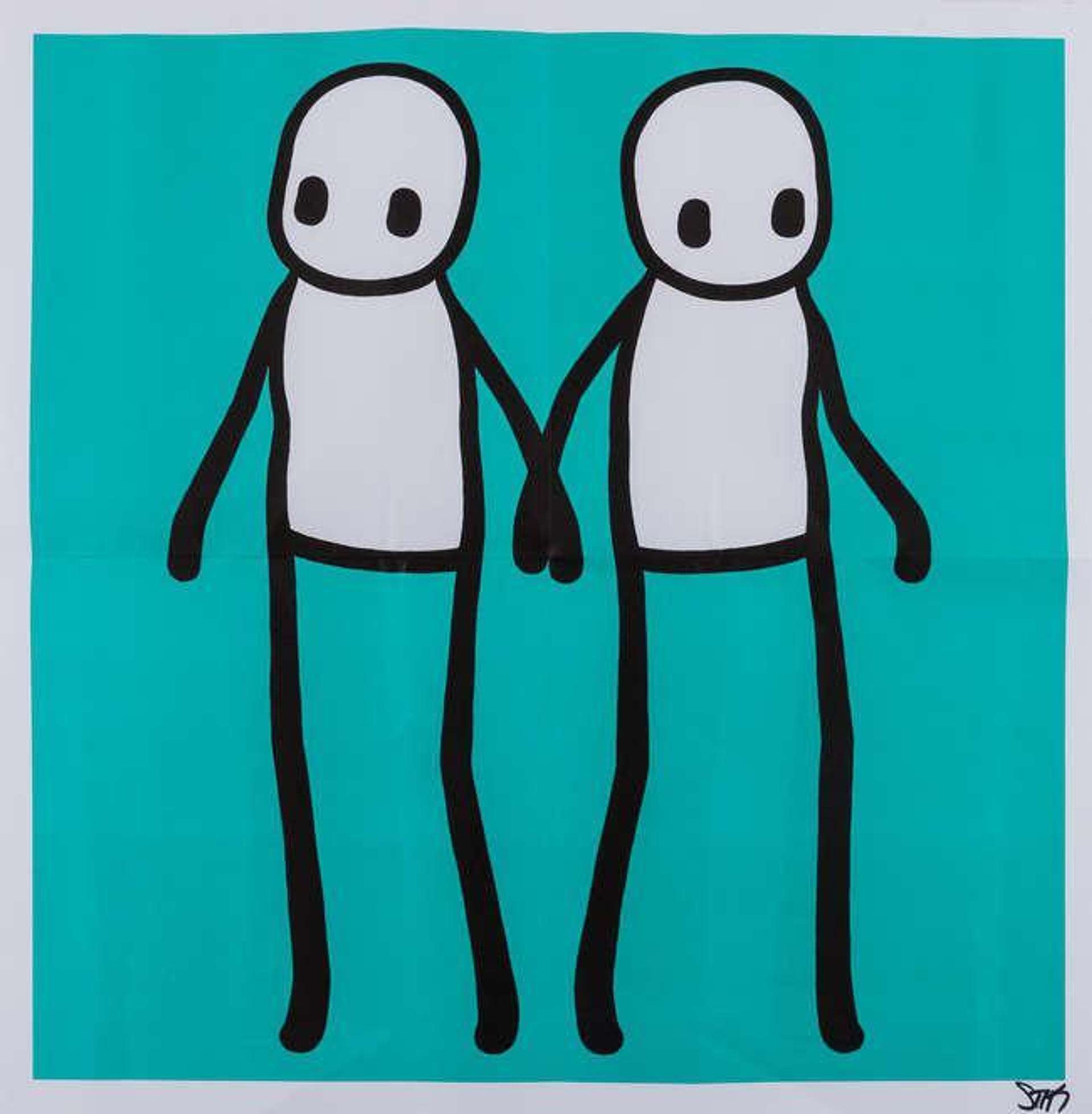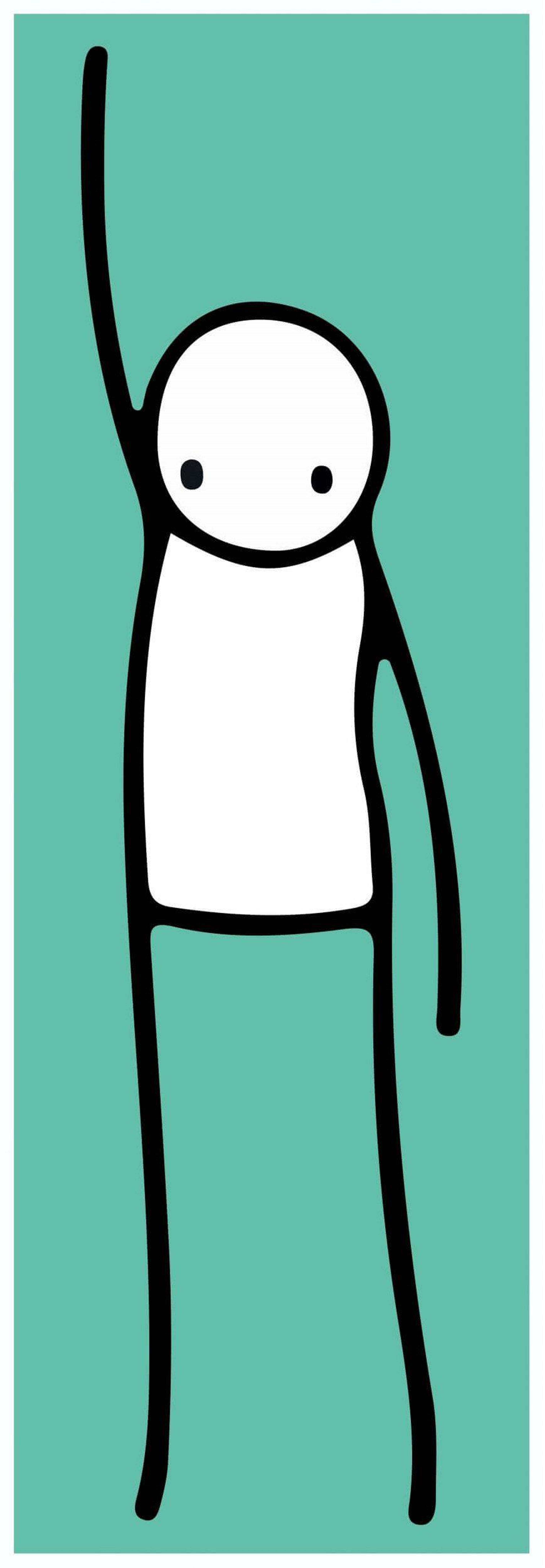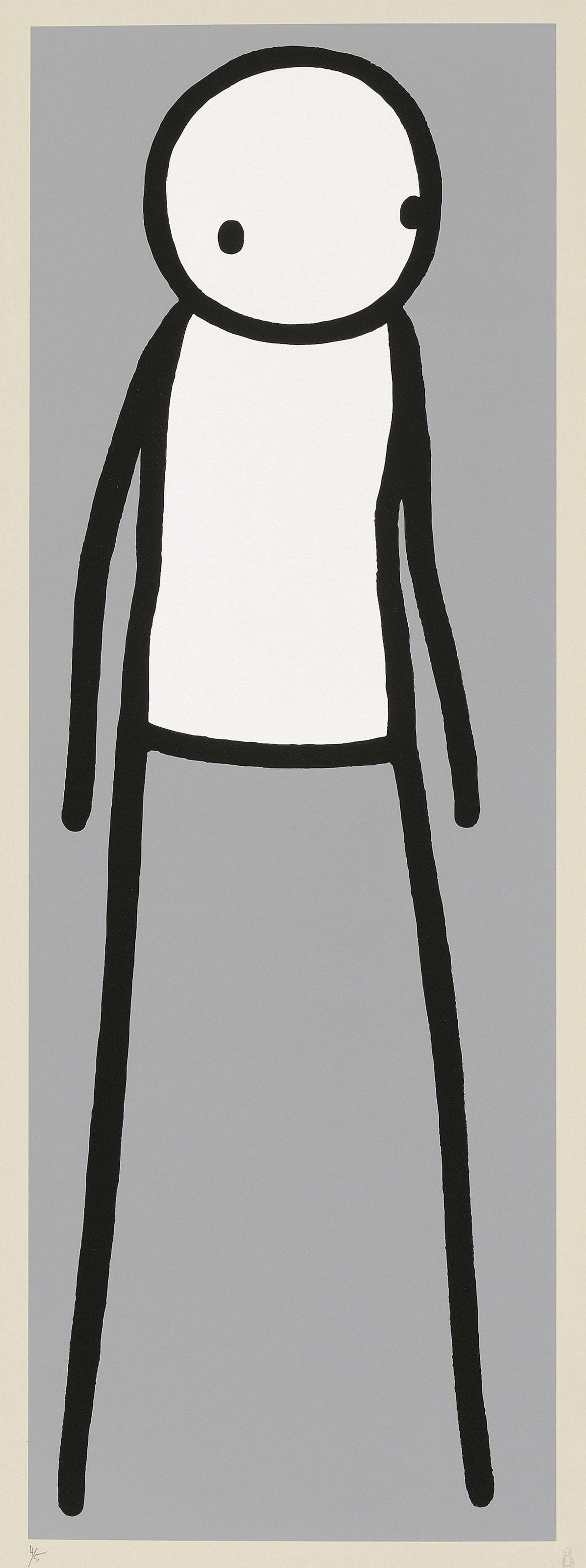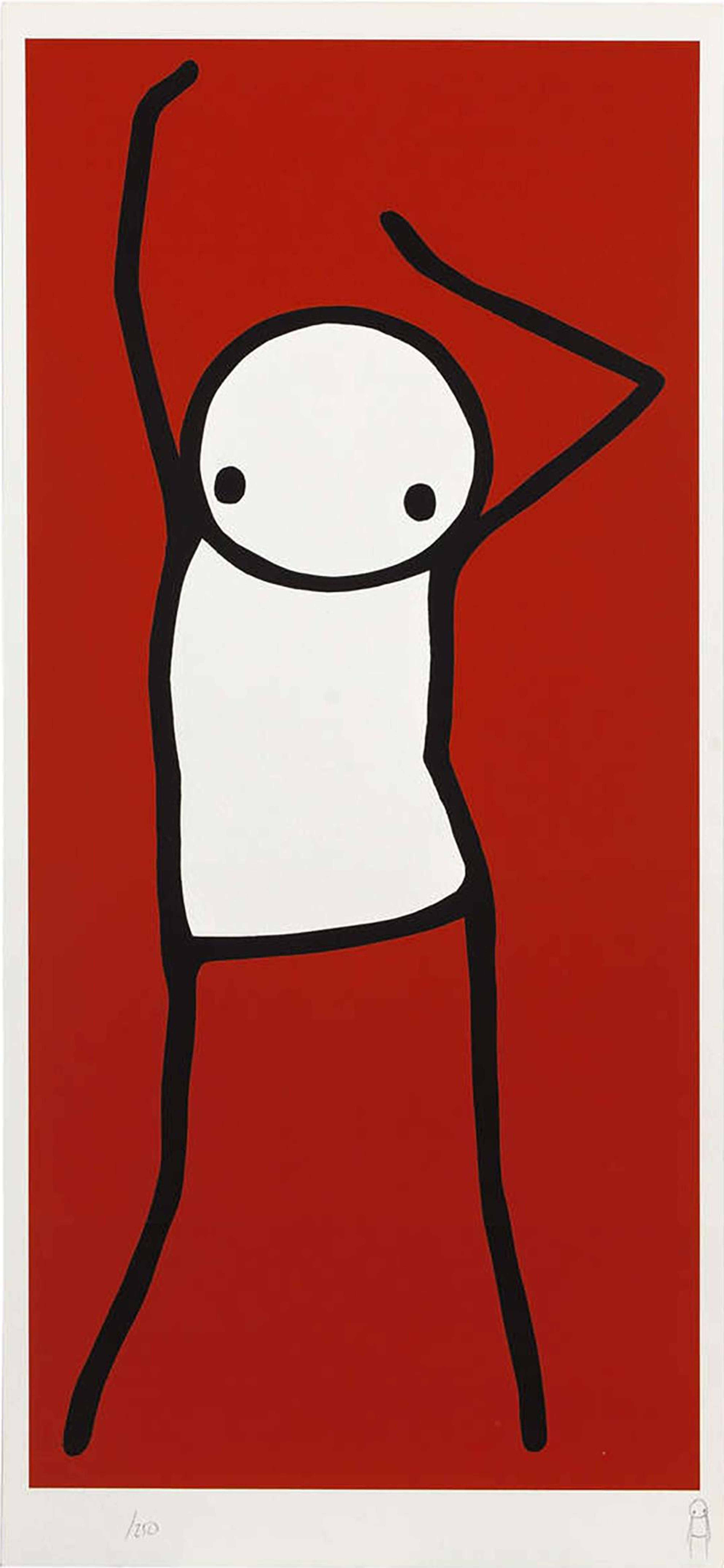 Rough Sleeper © STIK 2009
Rough Sleeper © STIK 2009
Stik
55 works
Despite his concealed identity, STIK's influence is undeniable. The simplistic figures he crafts, though void of facial detail, radiate with emotional depth, challenging our perceptions of anonymity and artistry. As discussions around STIK unfold, it's virtually impossible to bypass the significance of Brick Lane, the epicentre of London's street art movement, where many of his early iconic pieces made their debut. Beyond just serving as a backdrop, this location narrates STIK’s transformative journey from obscurity to global recognition.
A is for Anonymous
STIK's identity remains a well-guarded secret, a characteristic common to many street artists. Yet, his anonymity doesn't deter from the significant impact he has made in the art world. His works, characterised by stick figures that encapsulate profound human emotions, are in stark contrast to the nameless artist behind them. How does anonymity shape our perception of art and the narrative behind it?
B is for Brick Lane
It’s hard to talk about STIK without mentioning Brick Lane, London's heartbeat of street art. It's here that many of STIK’s early works first appeared. These initial murals, now iconic, solidified his position in the urban art movement. For STIK, Brick Lane became a testament to his journey from homelessness to worldwide acclaim.
C is for Community
A recurring theme in STIK's work is the sense of community. His simple, yet evocative stick figures often represent unity, solidarity, and the human experience across urban settings. STIK has not only reflected community in his artworks but also actively engaged in it. He has often used the sales of his art to support various community projects, solidifying the symbiotic relationship between the artist and the community that inspired him.
D is for Dualism
STIK's art showcases the concept of dualism. Despite their minimalist design, his figures express deep emotions. The blend of straightforward form with rich sentiment emphasises the intriguing aspects of human nature and our interactions. At our core, we might be simple beings navigating the complexities of modern life. STIK's works offer viewers a canvas to explore these reflections.
E is for Empathy
STIK’s works stand out for their profound sense of empathy. Drawing upon his own experiences, the artist employs his distinctive stick figures to represent a myriad of human emotions. While the figures appear simple, they engage in intricate interactions that resonate with the universal human experience.
F is for Figurative Simplicity
STIK's deliberate choice of figurative simplicity transcends linguistic and cultural barriers, making his work universally relatable. How does STIK manage to capture such deep emotions with just a few lines and dots? His art pushes us to reflect on the essence of human connection, proving that sometimes, less truly is more in the realm of artistic expression.
G is for Galleries
Over the years, STIK's works have graced not only the urban sprawl but also prestigious galleries. Transitioning from the streets to revered spaces such as the Dulwich Picture Gallery in London and major auction houses, his presence in these establishments emphasises the ever-blurring lines between street and contemporary art.
H is for Holding Hands
Human connection and a sense of community underpin STIK's oeuvre. His figures, though stripped of detailed features, exude empathy, loneliness, joy, and resilience. In a world where technology often overshadows human touch, STIK’s works serve as a compelling reminder of our inherent need for connection. His murals, often towering over busy streets, whisper tales of unity in an era of division and beckon viewers to find commonality in shared human experiences.
I is for Identity
STIK's characters are an exploration of human emotion and the nature of identity in a rapidly changing world. These enigmatic figures, with their minimalist form, prompt the viewer to question: How does anonymity shape our understanding of self and others in an age dominated by the digital avatar?
J is for Journey
STIK's journey from homelessness to being one of the UK's most recognised street artists is truly remarkable. London's Shoreditch and Hackney were both his canvas and his refuge. This personal history deeply influences his work, grounding it in themes of urban survival, community, and resilience.
K is for Keeping it Real
Authenticity remains paramount in STIK's art. Even as he gained more global recognition, he remained rooted in street art's core ethos of keeping it real. His pieces, regardless of location—from the East End alleys to Manhattan’s skyscrapers—always retain a universal, human touch.
L is for London
London isn't just STIK's hometown; it's the pulsating heartbeat of his artwork. The city’s diverse cultures, its history, and its vibrancy find reflections in his murals. Through his art, we’re able to experience London’s socio-cultural landscape, from gentrification debates to celebrations of unity.
M is for Murals
STIK’s legacy is firmly imprinted on the global landscape through his monumental murals. Often situated in urban settings, these murals not only beautify city walls but also infuse them with narratives of community, unity, and resilience. Historically, murals have been instruments for socio-political commentary; in STIK's hands, they become canvases narrating tales of contemporary society. Notably, his Hackney mural, highlighting the importance of community, is an emblematic representation of this theme.
N is for Notoriety
Emerging from the underground world of London’s street art scene, STIK's rise to international notoriety is nothing short of remarkable. Yet, even amidst growing acclaim, he’s maintained a conscientious approach to his art. As the focus on street art sharpens, STIK's work masterfully navigates between catering to popular demand and remaining faithful to his foundational ethos.
O is for Outreach
A cornerstone of STIK's artistry is his outreach initiatives. His commitment to local communities is evident not just in his murals that often reflect local sentiments, but also in his efforts to raise funds for various causes. For instance, the sale of one of his Holding Hands works generated funds for a community centre in London. These sort of gestures highlight the relationship between the artist and the communities he engages with.
P is for Prints
For STIK, crafting limited-edition prints isn't solely about broadening access to his work; it's also about navigating the challenges and opportunities of digital reproduction. As these pieces become hot commodities among collectors, the intrinsic value of STIK's prints shines through.
Q is for Quixotic Vision
STIK's pieces frequently paint a dreamlike interpretation of the world. By rebelling against the prevailing standards of street art, his featureless figures evoke deep emotions that resonate with many. STIK's talent lies in expressing profound human sentiments through starkly simple designs.
R is for Recognition
STIK's artistry, once confined to London's gritty corners, now graces global galleries, including New York's elite spaces. This Hackney street artist's ascent to international prominence is a testament to the universal appeal of his creations. By understanding street art's transformative journey, one can better appreciate the nuances of STIK's unparalleled success.
S is for Standing Embrace Sale
One of his early large-scale canvases, Standing Embrace transitioned from the hands of its original buyer in 2009 to Christie’s in London by 2020. Initially anticipated to fetch a commendable £70,000, the masterpiece shattered expectations, securing a staggering £156,250, highlighting the allure collecting works by STIK.
T is for Themes of Togetherness
Togetherness is a recurring theme in STIK's oeuvre. His often-solitary figures, despite their simplicity, communicate connections – be it with the environment, the viewer, or fellow figures in multi-character compositions. In an era marked by widespread alienation, STIK's emphasis on unity and connection can be seen as a reflection of age-old artistic traditions, underscoring the enduring pursuit of unity in a divided world.
U is for Up On The Roof
Featured in his debut solo exhibition, Up On The Roof is a rare piece, with only three of the original 16 artworks surviving today. Its auction trajectory is compelling considering its sibling piece, Bound, sold for £35,000 at Christie's in 2017 on top of Up On The Roof going for £150,000 the following year. Beyond its valuation, the piece's spirit lies in its philanthropy—the sale's proceeds empowered Cardboard Citizens, an East London charity championing the homeless.
V is for Vulnerability
Upon closer inspection, STIK's seemingly simple characters reveal a profound sense of vulnerability. The elongated shapes and expressive round eyes capture a raw emotion that echoes STIK's personal encounters with adversity and his solidarity with those on the fringes. It's this authentic embrace of vulnerability that lends STIK's work a universal appeal. People from all walks of life find a piece of themselves in his art, highlighting the shared human experience of fragility and resilience.
W is for Walk
The Walk series stands as a testament to STIK's mastery over minimalism. Premiered at London's Imitate Modern gallery, it delves deep into urban movement and the progression of STIK's style. Contrary to its name, the series emphasises an almost stationary figure, with the mere implication of motion seen in its sideward gaze. The traffic lightbox piece, featuring contrasting 'stop' and 'go' stick figures, captures the series' essence, juxtaposing movement and stillness. This series is not just about city motion but mirrors STIK's own journey, illustrating how he has moved, evolved, and transformed alongside the city he draws inspiration from.
X is for X-axis
Art often thrives in intricate layers, yet STIK stands out with his dedication to straightforwardness. His creations, evoking basic line drawings on a graph, navigate the X-axis of cityscapes with grace surpassing their fundamental design. Rooted in pure linear expression, his figures exude deep emotion. Amidst the bustling world of street art, STIK's reductionist style makes a powerful statement, underscoring the timeless truth that often, simplicity carries the loudest message.
Y is for Yellow
Yellow, a colour known to symbolise optimism, frequently adorns the backdrop of STIK's minimalist works. Beyond aesthetics, this shade evokes hope and joy, standing out starkly against urban grey landscapes. In STIK's art, yellow isn't just a colour—it's a narrative choice, turning simple figures into poignant commentaries on finding brightness amidst the mundane, urging viewers to see the world with hopeful resilience.
Z is for Zero
STIK's journey began at zero, with humble origins from the gritty streets of London. Yet, from these unassuming beginnings, he rose to international acclaim. His story serves as a poignant reminder that even in art, every grand success story has its starting point, its "zero," from which greatness emerges.



